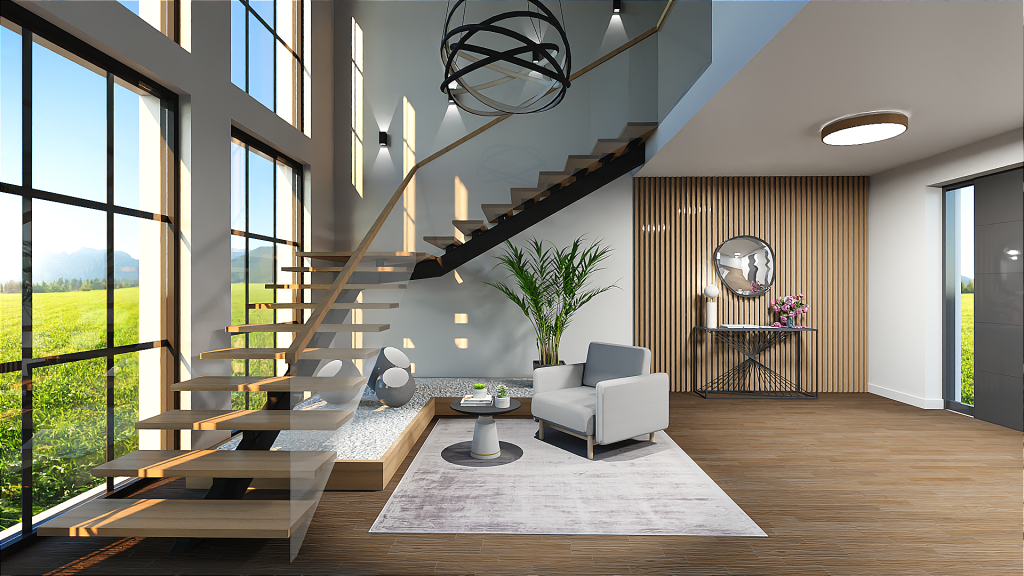Capturing a photo-realistic image requires more than just pressing a button.
It involves understanding how to handle lighting and shadows, being knowledgeable about the physical properties of materials, identifying the ideal point of view, and gradually constructing an image that appears authentic. The new Rendering Engine of ARCHLine.XP 2023 offers a simple and fast solution for creating photorealistic renderings that will take your designs to the next level. In this article, we'll take a closer look at the new render module and its state-of-the-art visualization features.
These guidelines only pertain to ARCHLine.XP 2023.
The following guide is intended for beginners and outlines the main steps. While there are various methods to obtain a high-quality, photo-realistic image, achieving good rendering is a result of numerous settings that can be negatively affected by the slightest mistake. Learning, testing, and experimenting are essential to progress.
Let's start by reviewing all the new presets and features.
Rendering Presets
In terms of presets, the "Low (Q1), Medium (Q2) and Custom (Qx)" levels allow you to consciously create the best quality image in a few steps. The "Q1" setting is perfect for producing a work-quality image at the beginning of the render process with a low resolution. The "Q2" setting is ideal for scenes approaching the final image, while the "Qx" setting can be adjusted to the user's needs, values can be specified individually based on the number of light sources and the complexity of the model.
Samples Per Pixel
The number of ray-tracing samples computed per pixel of the output image adjusts anti-aliasing, which will smooth away the "jaggies" you see along the edges of objects and shadows. Increasing Pixel Samples will result in a cleaner, higher quality image. For final renders with complex lighting, choose 10 or higher; for quick drafts, choose less than 5.
Render Pass Count
The render engine uses a progressive rendering method, which further refines the generated image during each rendering pass. Increasing the render pass number will increase the time required to perform rendering but will also increase the image's quality per each single pass. The required number of passes is highly dependent on the kind of scene that is being rendered. A higher sampling setting (>10) is useful for scenes with complex lighting, while a lower sampling setting (<10) is useful for scenes that require detailed geometry, fine textures, without complex lighting. The recommended value for the final image is 30.
Denoiser Module
The Denoiser module will denoise the entire scene at the end or when rendering is interrupted. It removes image noise while recovering and enhancing the details, resulting in sharper details and a cleaner, higher quality image.
New post-process effect – Sharper details
This effect reduces noise while enhancing and recovering details in your image. When turned on, it can produce striking, highly-detailed images that are sure to impress. However, if you prefer a softer, more subtle look, simply turn the effect off to achieve a different effect.
Guide:
1. Use layers to separate architectural elements, large furniture, lamps and other objects.
2. Establish 2-3 perspective views to showcase the scene effectively. Suggested values include setting the viewer and viewed point at the same height (between 1.10-1.40 m) and an opening angle between 60-75 degrees.
3. Start by setting the position of the sun. For a daytime scene, make sure the sun is up on the horizon, between 8am and 4pm.
4. Set the date and time of the scene.Use the shadow simulation to see how much light comes in and adjust the settings if needed.
5. Divide your workflow to 3 phases: architectural elements, larger furniture, and decorative elements. For a scene with a complex lighting, you can divide up to 4 parts, paying special attention to the lights. Repeat steps 6-8 for each phase.
6. Use drag-and-drop to assign render styles to them as a starting point.
7. Create a test render with a lower resolution, such as 800x600, and use the Q1 preset for a fast, preliminary image.For furniture, use a closer view to see the materials well.
8. Fine-tune the materials based on the image if necessary.
9. If everything is going as planned so far, activate the layers containing all elements.
10. Start another test render with higher resolution, such as 1280x720 and use the Q2 render preset for a cleaner, higher quality image.
11. If the test rendering quality is satisfactory, proceed to the final rendering at high resolution (Full HD, 1920*1280 or higher if required), and use the Qx custom preset with individually adjustable values based on the number of light sources and the complexity of the model.This could take up to 30-60 minutes. It depends on the computer, the scene and resolution. The higher resolution will increase render time.
12. Use the effects! Post-processing is a crucial step in the rendering process that professionals undertake. Adjusting parameters such as brightness, contrast, saturation, and white balance can significantly enhance the quality of the final image, for example, by making it warmer or cooler. Small changes of 5-10 percent can significantly impact the final scene.
13. Try out the sharper details function! Enabling the effect can create impressive, highly-detailed images. Turning it off will result in a softer, more subtle look.
Conclusion
The new Rendering Engine of ARCHLine.XP 2023 offers a fast and simple solution for creating photorealistic renderings that will bring your designs to life. With advanced shading effects, customizable settings, and the Denoiser module, you can easily create stunning renderings. Whether you're an advanced user or a beginner, the new render module can be used according to your habits, technical knowledge, or preferences. So, why wait? Try out the new Render Module of ARCHLine.XP 2023 and take your designs to the next level!
